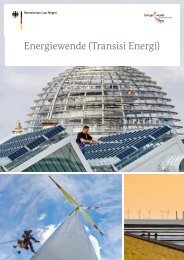The German Energiewende
You also want an ePaper? Increase the reach of your titles
YUMPU automatically turns print PDFs into web optimized ePapers that Google loves.
26 | <strong>The</strong> <strong>German</strong> <strong>Energiewende</strong><br />
Storage<br />
Energy on tap<br />
© dpa/Hannibal Hanschke<br />
By 2050, <strong>German</strong>y wants to source 80 percent of its electricity from renewables, mainly from<br />
wind turbines and PV systems. When clouds suddenly appear or the wind drops without<br />
warning, the country needs an electricity system that can adapt quickly and flexibly to the<br />
situation. Energy storage systems provide a solution. When there is plenty of wind and<br />
sunshine, they can store electricity, which they then release as needed during times of low<br />
production, darkness or overcast weather.<br />
Home storage: batteries<br />
Combination of a PV system and a battery for self-supply<br />
and grid feed-in<br />
Pumped storage: using natural reservoirs<br />
Diagram of a pumped storage system<br />
Upper reservoir<br />
PV system<br />
Motor/<br />
generator<br />
Transformer<br />
1.<br />
2.<br />
Battery storage<br />
Pump-turbine<br />
Lower reservoir<br />
Self-supply: direct use<br />
of solar-generated<br />
electricity or battery<br />
Grid feed-in of<br />
surplus electricity<br />
1.<br />
STORING ENERGY:<br />
(Surplus) electricity powers turbines.<br />
Water is pumped into the upper reservoir.<br />
2.<br />
RELEASING STORED ENERGY:<br />
Water flows downwards, powering the turbines.<br />
<strong>The</strong> turbines generate electricity and feed it into the grid.<br />
100,000 battery storage systems in use 9.2 GW generating capacity; 4.5 GW under construction<br />
<strong>The</strong>re are many types of storage solutions. Short-term storage options, such as batteries,<br />
capacitors and flywheel systems, can take in and release electrical energy several times over<br />
the course of a day. However, their capacity is limited.<br />
<strong>German</strong>y mainly uses pumped storage plants to store electricity for a longer period of time.<br />
<strong>The</strong>se plants, some of which are in Luxembourg and Austria, currently have a capacity of<br />
around nine gigawatts connected to the <strong>German</strong> grid. Although this gives <strong>German</strong>y the largest<br />
pumped storage capacity in the EU, there is only limited scope for expansion. <strong>German</strong>y is<br />
therefore working closely with countries that have large storage capacities. Austria, Switzerland<br />
and Norway are the most important countries.<br />
2013<br />
<strong>The</strong> first completely newly<br />
developed electric drive car is<br />
mass-produced in <strong>German</strong>y.<br />
2013<br />
<strong>The</strong> first industrial-scale power-to-gas plant<br />
goes online in <strong>German</strong>y.<br />
2014<br />
<strong>German</strong>y reforms the Renewable Energy Sources<br />
Act. <strong>The</strong> Act now includes annual development<br />
targets and imposes market integration.

















